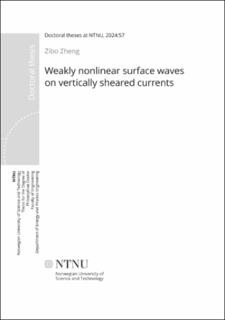| dc.contributor.advisor | Ellingsen, Simen Ådnøy | |
| dc.contributor.advisor | Li, Yan | |
| dc.contributor.author | Zheng, Zibo | |
| dc.date.accessioned | 2024-03-06T12:52:42Z | |
| dc.date.available | 2024-03-06T12:52:42Z | |
| dc.date.issued | 2024 | |
| dc.identifier.isbn | 978-82-326-7713-9 | |
| dc.identifier.issn | 2703-8084 | |
| dc.identifier.uri | https://hdl.handle.net/11250/3121298 | |
| dc.description.abstract | Extreme waves, also known as rogue waves, have much larger heights than surrounding waves, which are of great danger to ships and coastal structures. A subsurface shear current is able to change the properties of the surface waves significantly. Hence, rogue waves may be altered by a shear current. This thesis aims to investigate the effects of a vertically sheared background flow on weakly nonlinear deep-water waves with both a statistical study for irregular random waves and a deterministic study for a focused wave group.
First, we extend the theory of Longuet-Higgins [J. Fluid Mech. 12, 321 (1962)] to allow for a background shear flow that varies with depth. The theory is valid up to second order in wave steepness. It is applicable to arbitrarily strong shear currents and broadband waves. The linear dispersion relation and wave field are solved by the Direct Numerical Method (DIM) proposed by Li and Ellingsen [J. Geophys. Res.: Oceans, 124, 2527 (2019)]. The second-order corrections are solved numerically from the Rayleigh equation with the finite volume method.
To examine the effects of different shear currents on the statistics of weakly nonlinear waves, we perform simulations and generate random waves with both numerical cases and real-world data from the mouth of the Columbia River. For numerical cases, a JONSWAP spectrum and several different linear and exponential shear currents with reasonable strength are adopted. The real-world data is measured by Zippel and Thomson [J. Geophys. Res.: Oceans 122, 3311 (2017)]. We investigate the probability density function of wave surface elevation and maxima, exceedance probability distribution of crest height, maximum wave crest among a number of consecutive waves, and the skewness of the surface elevation. The simulating results of both numerical cases and real-world data demonstrate that an opposing shear enhances the probability of rogue waves and skewness, while a following shear has opposite influences compared with the no-current case.
Knowing that the shear current can have a considerable influence on rogue waves, we proceed to examine the focused wave group on different shear currents, which acts as a representation of the rogue wave event. The investigations are carried out for both long-crested linear and weakly nonlinear waves.
Linear waves: For a prescribed initial wave group surface elevation, different techniques are used to derive explicit approximate expressions of wave surface elevation and orbital velocity profiles. The approximate expressions agree well with the numerical results from DIM. Compared to the case without a current, orbital velocities are significantly amplified by a following shear and suppressed by an opposing shear; an amplification factor is defined from here, and the approximate expression of the amplification factor with respect to the parameters of a shear current is derived explicitly. Compared to the no-current case, a reasonably strong shear alters the orbital velocities substantially. The present expressions can be tested by future experiments at the NTNU fluid mechanics laboratory.
Weakly nonlinear waves: The nonlinear waves are solved numerically similar to the statistical study. We use Gaussian energy spectra to generate linear wave groups. The exponential shear currents are assumed to propagate at an arbitrary angle to the wave groups. The measured wave spectra and shear currents are also used in the calculation for comparison. The wave surface elevation and horizontal velocity beneath the focused point are analyzed. Our results suggest that in regions of strong oceanic currents, substantial error occurs in predicting wave impact on ocean structures if the shear currents are ignored. | en_US |
| dc.language.iso | eng | en_US |
| dc.publisher | NTNU | en_US |
| dc.relation.ispartofseries | Doctoral theses at NTNU;2024:57 | |
| dc.relation.haspart | Paper 1: Zheng, Zibo; Li, Yan; Ellingsen, Simen Andreas Ådnøy. Statistics of weakly nonlinear waves on currents with strong vertical shear. Physical Review Fluids 2023 ;Volum 8. https://doi.org/10.1103/PhysRevFluids.8.014801 | en_US |
| dc.relation.haspart | Paper 2: Ellingsen, Simen Ådnøy; Zheng, Zibo; Abid, Malek; Kharif, Christian; Li, Yan. Dispersive Wave Focusing on a Shear Current: Part 1—Linear Approximations.
The final published version is available in
Water Waves 2024 https://doi.org/10.1007/s42286-024-00085-3 - This article is licensed under a Creative Commons Attribution 4.0 International License CC BY | en_US |
| dc.relation.haspart | Paper 3: Zheng, Zibo; Li, Yan; Ellingsen, Simen Andreas Ådnøy. Dispersive wave focussing on a shear current. Part 2: effect of weak nonlinearity | en_US |
| dc.title | Weakly nonlinear surface waves on vertically sheared currents | en_US |
| dc.type | Doctoral thesis | en_US |
| dc.subject.nsi | VDP::Technology: 500::Environmental engineering: 610 | en_US |

